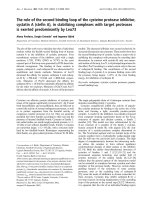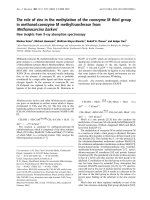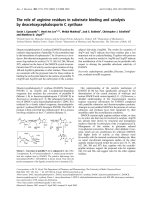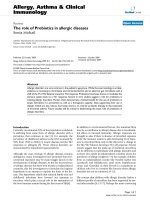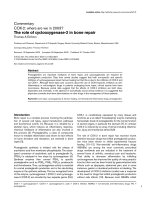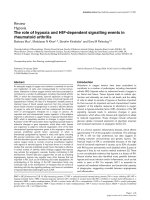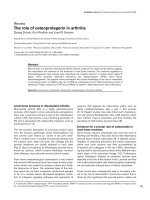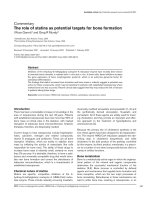Báo cáo y học: " The role of tibialis posterior fatigue on foot kinematics during walking Research" doc
Bạn đang xem bản rút gọn của tài liệu. Xem và tải ngay bản đầy đủ của tài liệu tại đây (633.88 KB, 8 trang )
JOURNAL OF FOOT
AND ANKLE RESEARCH
Pohl et al. Journal of Foot and Ankle Research 2010, 3:6
/>Open Access
RESEARCH
BioMed Central
© 2010 Pohl et al; licensee BioMed Central Ltd. This is an Open Access article distributed under the terms of the Creative Commons At-
tribution License ( which permits unrestricted use, distribution, and reproduction in any
medium, provided the original work is properly cited.
Research
The role of tibialis posterior fatigue on foot
kinematics during walking
Michael B Pohl*
1
, Melissa Rabbito
1
and Reed Ferber
1,2
Abstract
Background: The purpose of this study was to investigate the effect of localised tibialis posterior muscle fatigue on
foot kinematics during walking. It was hypothesised that following fatigue, subjects would demonstrate greater
forefoot and rearfoot motion during walking. It was also postulated that the magnitude of the change in rearfoot
motion would be associated with standing anatomical rearfoot posture.
Methods: Twenty-nine subjects underwent an exercise fatigue protocol aimed at reducing the force output of tibialis
posterior. An eight camera motion analysis system was used to evaluate 3D foot kinematics during treadmill walking
both pre- and post-fatigue. The anatomical rearfoot angle was measured during standing prior to the fatigue protocol
using a goniometer.
Results: Peak rearfoot eversion remained unchanged following the fatigue protocol. Although increases in rearfoot
eversion excursion were observed following fatigue, these changes were of a magnitude of questionable clinical
significance (<1.0°). The magnitude of the change in rearfoot eversion due to fatigue was not associated with the
anatomical measurement of standing rearfoot angle. No substantial changes in forefoot kinematics were observed
following the fatigue protocol.
Conclusions: These data indicate that reduced force output of the tibialis posterior muscle did not alter rearfoot and
forefoot motion during gait. The anatomical structure of the rearfoot was not associated with the dependence of
muscular activity that an individual requires to maintain normal rearfoot kinematics during gait.
Background
The structural integrity of the foot during gait is believed
to be a combination of bony, ligamentous and muscular
support [1-4]. Although cadaveric studies have demon-
strated that muscles assist in maintaining both rearfoot
and midfoot posture [4,5], little research has been con-
ducted regarding the in-vivo contribution of muscular
activity to controlling foot pronation during gait. The tib-
ialis posterior is believed to play a key role as an invertor
of the rearfoot [6] in addition to providing dynamic sup-
port across the midfoot [4,5]. The importance of the tibi-
alis posterior has been highlighted by biomechanical
research conducted on patients with posterior tibialis
tendon dysfunction (PTTD). Studies conducted using
multi-segment foot models showed that patients with
PTTD demonstrated foot kinematics consistent with an
excessively pronated foot during gait [7-9]. In particular,
PTTD patients exhibited greater and prolonged rearfoot
eversion and forefoot dorsiflexion, in addition to greater
forefoot abduction, compared to controls. However, the
contribution that tibialis posterior plays in controlling
pronation in healthy individuals has received little atten-
tion.
One method of assessing a muscle's contribution to a
specific movement pattern is via fatigue-inducing exer-
cise of that muscle. For example, Christina et al. [10]
showed that localised fatigue of the invertors resulted in a
trend towards greater rearfoot eversion during running.
In the afore mentioned study, fatigue of the invertors was
achieved using open chain resisted supination exercises.
Research has shown that selective activation of tibialis
posterior was better achieved using closed chain resisted
foot adduction as opposed to open chain supination [11].
Therefore, to better understand the role of tibialis poste-
rior fatigue on foot mechanics it seems prudent to use an
exercise that more selectively activates this muscle.
* Correspondence:
1
Running Injury Clinic, Faculty of Kinesiology, University of Calgary, Calgary, AB,
Canada
Full list of author information is available at the end of the article
Pohl et al. Journal of Foot and Ankle Research 2010, 3:6
/>Page 2 of 8
While rearfoot motion during gait has received much
attention in the literature, its relationship with anatomi-
cal structure remains unclear. For instance, the standing
rearfoot angle has been shown to be associated with rear-
foot eversion during walking [12]. In contrast, Cornwall
and McPoil [13] showed no relationship between static
and dynamic rearfoot motion. The conflicting findings
may be due to neglecting the role of muscular support
when studying the relationship between the static and
dynamic behaviour of the rearfoot. For example, subjects
with a pronated foot posture have been shown to exhibit
increased tibialis posterior activity compared to those
with a normal foot structure [14]. It may be that individu-
als with structural deficiencies such as excessive rearfoot
valgus, rely more heavily on muscular contribution to
control rearfoot kinematics during gait. Thus, it might be
expected that these subjects would undergo greater
changes in rearfoot kinematics following fatiguing exer-
cise of a major invertor muscle.
The purpose of this study was to examine the effect of
localised tibialis posterior muscle fatigue on foot kine-
matics during walking. It was hypothesised that following
a bout of fatigue-inducing exercise subjects would dem-
onstrate greater and prolonged rearfoot eversion and
forefoot dorsiflexion, as well as greater forefoot abduc-
tion. A secondary aim was to understand whether the
magnitude of the changes in rearfoot eversion due to
fatigue were associated with the anatomical measure-
ment of standing rearfoot angle. Hence, it was hypothe-
sised that following fatigue, subjects who underwent the
greatest increases in rearfoot eversion during walking
would demonstrate a greater standing rearfoot valgus
posture.
Methods
Subjects
Based on a within group standard deviation of 5.5° (rear-
foot kinematic data from Pohl et al. [15]) and an expected
15% difference between pre and post measures, α = 0.05,
β = 0.80, we found that 28 subjects were needed to pro-
vide sufficient power for this study. Twenty-nine (11
males, 18 females) recreationally active subjects (mass;
mean = 68.8 kg, SD = 13.5 kg) with a mean (SD) age of
27.3 years (8.1) volunteered to participate in the study. All
subjects were currently free from lower extremity injury,
had no prior history of surgery to the foot and lower leg,
and were familiar with treadmill walking. The study was
approved by the institutional ethics board, and written
informed consent was obtained from all subjects.
Data collection protocol
Prior to the gait analysis, a structural assessment of each
subject's rearfoot was conducted once by a single experi-
enced athletic therapist. With the subject lying prone,
lines were drawn bisecting the lower third of the leg and
the calcaneus. The relaxed standing rearfoot angle,
defined as the calcaneus relative to the tibia, was then
measured using a goniometer with the feet placed bi-
acromial width apart [16].
Following the structural measurement, three-dimen-
sional kinematic data were then collected for all subjects
walking on a treadmill both prior to, and following,
fatigue-inducing exercise of the tibialis posterior muscle
of the right limb. Seventeen reflective markers (9 mm
diameter) were attached to the skin of the forefoot, rear-
foot and shank of the right limb [17]. An additional
marker was placed on the dorsal aspect of the phalanx.
Marker trajectory data were collected at 120 Hz using an
eight camera motion analysis system (Vicon Motion Sys-
tems Ltd, Oxford, UK) arranged around a treadmill (Star-
Trac, Irvine, USA). Prior to commencement of the
walking trials, a static calibration trial was recorded: sub-
jects assumed a relaxed standing position with their feet
positioned 0.30 m apart and toes pointing straight ahead.
Subjects then completed treadmill walking at 1.1 ms
-1
while ten footfalls were collected to represent the "pre-
fatigue" (PRE) condition. The marker-base attachment on
the first metatarsal head was drawn around and then sub-
sequently removed during the fatigue protocol. None of
the other markers were removed. Upon completion of the
fatigue exercise protocol, the first metatarsal base/marker
was replaced in the same location using the outline and
subjects immediately mounted (within 15 seconds) the
moving treadmill to complete the "post-fatigue" (POST)
walk.
Fatigue protocol
In the present study, muscle fatigue was defined as a
reduction in the capacity of the muscle to perform work
or generate force [10]. Tibialis posterior was fatigued
using closed chain resisted foot adduction motion. This
exercise was chosen since previous MRI research indi-
cated that tibialis posterior was selectively activated dur-
ing its performance compared to open chain inversion
[11]. Subjects were seated in a chair while their right foot
was placed in a custom built device (Figure 1a) that
allowed them to perform concentric/eccentric foot
adduction contractions with adjustable resistance, similar
to Kulig et al. [18]. The subjects legs were stabilised by
placing a ball (diameter = 16 cm) between their knees and
then strapping both lower legs together and both thighs
to the chair (Figure 1a). The custom built device also con-
tained a dynamometer (Lafayette Instrument, Lafayette,
USA: Model 01163)) which was fixed against the 1
st
meta-
tarsal head of the subject to enable the measurement of a
maximal voluntary contraction (MVC) during isometric
foot adduction. Prior to the commencement of the
fatigue-inducing exercise, the mean of three MVC trials
Pohl et al. Journal of Foot and Ankle Research 2010, 3:6
/>Page 3 of 8
were taken to represent force output for the PRE condi-
tions. Then with the ankle positioned in 20° plantarflex-
ion, subjects performed sets of 50 concentric/eccentric
contractions at 50% MVC through a 30° range of motion
(Figure 1b). The subjects were allowed 10 seconds of rest
between each set and after every four sets, MVCs were
performed (Figure 2). The sets were continued until sub-
jects MVCs had dropped below 70% of the PRE values or
they were unable to complete two consecutive sets. A
final set of MVCs were taken immediately following the
post-fatigue walk (within 2 minutes) to determine
whether subjects had recovered in terms of force output
during the walking trial.
Data reduction
Ten foot falls for the PRE and POST kinematic walking
data were selected for analysis. Raw marker trajectory
data were filtered using a fourth order low-pass Butter-
worth filter at 12 Hz. Visual3D software (C-motion Inc,
Rockville, USA) was used to create anatomical co-ordi-
nate systems for the shank, rearfoot and forefoot, and cal-
culate three-dimensional segment angles [15]. All
segment angles were defined as motion measured relative
to the next most proximal segment [7,9]. All kinematics
were analysed for the stance phase and normalised to 101
data points. The stance phase was determined using kine-
matic marker data. Initial contact (IC) and toe off (TO)
were identified using a velocity-based algorithm [19]
applied to the posterior calcaneal and dorsal phalanx
markers respectively. Custom Labview (National Instru-
ments Corp, Austin, USA) software was used to extract
the following kinematic variables of interest for each sub-
ject: rearfoot peak eversion (EVE), rearfoot EVE excur-
sion, time to peak rearfoot EVE, forefoot peak
dorsiflexion (DF), forefoot DF excursion, time to peak
forefoot DF, forefoot peak abduction (ABD). Peak values
were defined as the peak angle that occurred during the
stance phase. Excursion was defined as the angular dis-
placement between IC and the peak value.
Data analysis
Group descriptive statistics were calculated for each vari-
able for both PRE and POST fatigue conditions. Paired
sample t-tests were conducted for the kinematic variables
of interest for between-condition statistical comparison.
The relationship between the anatomical standing rear-
foot angle and the changes in rearfoot kinematics follow-
ing fatigue was examined using a pearson-product
moment correlation. Significance for all tests was set at
an alpha level of P < 0.05 and all analyses were under-
taken using SPSS 15.0 (SPSS Inc, Chicago, USA). To
examine the reliability of the kinematic walking data five
subjects completed two within-day walking sessions. All
markers remained on the subject with the exception of
the first metatarsal head, which as described earlier, was
removed following the first trial and subsequently
Figure 1 Setup for the fatigue-inducing exercise and measure-
ment of MVCs. The complete setup is shown in (A) with the subject
strapped into a chair with ball placement and leg straps included. The
foot is positioned on a sliding foot plate (1) and foot adduction is
achieved by the subject pushing their 1
st
metatarsal head against the
dynamometer (3). The MVCs were measured by locking the foot plate
while the subject pushed isometrically against the dynamometer. A
pulley system that allowed the placement of weights (2) provided ad-
justable resistance while the subject performed the fatiguing exercise
through a 30° range of motion (B).
Figure 2 Timeline of the experimental fatigue protocol. Subjects
who were unable to complete two consecutive sets of 50 reps had a
final set of MVCs collected and proceeded directly to POST treadmill
walking.
PRE Treadmill walk
3x Isometric MVCs
50 reps
50 reps
50 reps
50 reps
3x Isometric MVCs
<70% of baseline MVC?
No
Yes
POST Treadmill walk
PRE Treadmill walk
3x Isometric MVCs
50 reps
50 reps
50 reps
50 reps
3x Isometric MVCs
<70% of baseline MVC?
No
Yes
POST Treadmill walk
Pohl et al. Journal of Foot and Ankle Research 2010, 3:6
/>Page 4 of 8
replaced for the second trial. The between-session kine-
matic curve offsets for rearfoot frontal, forefoot sagittal
and transverse plane motion were assessed using average
root mean squared error (RMSE). The RMSE was quanti-
fied in degrees, the same unit of measurement used for
the pre-post fatigue analyses.
Results
Force output
The mean (SD) baseline isometric force output was mea-
sured at 66.2 N (28.3). Following the fatiguing exercise
protocol the mean MVC force output dropped to 44.6 N
(21.8) which equated to 67% of the pre-fatigue baseline
value. Eight subjects failed to drop below the predeter-
mined force output of 70% baseline MVC. However, these
subjects were still included in the analysis since they were
unable to complete two consecutive sets due to fatigue.
Further, all eight subjects experienced at least a 21%
reduction in force output (MVC was less than 79% of the
baseline value). Immediately following the post-fatigue
walk, force output had increased slightly to be 80% of the
baseline value.
Kinematics
The reliability analysis performed on the subset of five
subjects revealed average RMSE of 0.9°, 1.1° and 0.6° for
rearfoot frontal, forefoot sagittal and forefoot transverse
plane motion respectively.
Mean ensemble kinematic curves of the rearfoot (rela-
tive to the shank) and the forefoot (relative to the rear-
foot) are shown in Figure 3. The mean (SD) values for all
kinematic variables of interest are presented in Table 1.
Following fatiguing exercise of tibialis posterior, there
was a significantly greater amount of rearfoot EVE excur-
sion from the pre-fatigue condition (0.7°). There were no
significant differences in rearfoot peak EVE or the time to
peak EVE following the fatigue protocol.
In terms of the forefoot, the only significant change fol-
lowing fatigue was found for forefoot peak ABD.
Although statistically significant, the increase in peak
forefoot ABD was only 0.3° compared to the pre-fatigue
condition. There were no significant changes in forefoot
peak DF, DF excursion, or time to peak DF.
The individual changes in foot kinematics are pre-
sented for the variables that were significantly altered fol-
lowing the fatiguing exercise (Figure 4). Twenty-two out
of the total 29 (76%) subjects had greater rearfoot EVE
excursion following fatigue. However, only 12 of these
subjects demonstrated kinematic changes that exceeded
the magnitude of the within-day precision error. Of the
17 subjects (58%) that had an increase in peak forefoot
ABD following the fatigue protocol, only 5 underwent
increases that exceeded the magnitude of the precision
error.
Structure and kinematics
The mean (SD) anatomical standing rearfoot angle for all
subjects was measured at 6.8° (2.7°) of eversion. The
standing rearfoot angle was poorly correlated with the
kinematic changes in both peak rearfoot eversion (r = -
0.19, P = 0.32) and excursion (r = -0.28, P = 0.15) follow-
ing fatigue.
Discussion
The purpose of this study was to examine the changes in
foot kinematics during walking following fatigue of the
tibialis posterior muscle. In contrast with our original
hypotheses, the results suggested that fatiguing exercise
did not induce substantial changes in the magnitude or
timing of rearfoot frontal plane kinematics during walk-
ing. Additonally, visual inspection of the kinematic
curves (Figure 3) revealed no apparent differences
throughout any part of the stance phase. There appeared
to be no relationship between the static anatomical struc-
ture of the rearfoot with the magnitude of the change in
rearfoot kinematics following fatigue. Contrary to our
expectations, forefoot sagittal and transverse plane kine-
matic variables also remained unaffected following
fatigue.
Table 1: Group mean (SD) rearfoot and forefoot kinematic variables for the pre- and post-fatigue conditions.
Variable PRE POST Mean Diff. 95% CI
Effect size#
P
Rearfoot peak EVE (°) -1.8 (3.4) -2.0 (3.4) 0.2 0.0 to 0.5 0.51 0.06
Rearfoot EVE excursion (°) -6.5 (1.9) -7.2 (1.8) 0.7 0.3 to 1.0 1.04 0.00*
Time to peak EVE (% stance) 44.9 (11.4) 46.7 (10.8) -1.8 -4.7 to 1.0 0.34 0.20
Forefoot peak DF (°) 4.3 (2.8) 3.5 (2.8) 0.8 0.0 to 1.7 0.53 0.06
Forefoot DF excursion (°) 9.3 (3.0) 9.7 (3.1) -0.5 -0.9 to 0.1 0.44 0.10
Time to peak DF (% stance) 70.4 (8.1) 69.3 (9.3) 1.2 -1.4 to 3.7 0.25 0.35
Forefoot peak ABD (°) -10.4 (6.5) -10.7 (6.3) 0.3 0.0 to 0.6 0.57 0.04*
*Indicates significant difference between PRE and POST (P < 0.05). 95% CI - 95% confidence interval of the difference.
#
Cohen's d calculation.
Pohl et al. Journal of Foot and Ankle Research 2010, 3:6
/>Page 5 of 8
Figure 3 Ensemble mean (SD) kinematic curves for both pre- and post-fatigue of rearfoot and forefoot motion. SD is only shown for the PRE
condition to improve clarity of the charts.
a) Rearfoot Inversion(+)/ Eversion(-)
-10
-5
0
5
10
15
20
0 204060801
% Stance
Angle (º)
00
PRE
POST
TOIC
b) Forefoot Plantar(-)/ Dorsiflexion(+)
-30
-20
-10
0
10
0 20 40 60 80 100
% Stance
Angle (º)
PRE
POST
IC TO
c) Forefoot Abduction(+)/ Adduction(-)
-20
-10
0
10
20
0 20406080
% Stance
Angle (º)
100
PRE
POST
TOIC
Pohl et al. Journal of Foot and Ankle Research 2010, 3:6
/>Page 6 of 8
To investigate the relationship between tibialis poste-
rior fatigue and foot kinematics a protocol for reducing
the force output of this muscle was developed. The
results indicate that fatigue protocol was successful in
reducing the isometric force by over 30%, and that this
force attenuation remained following the post-fatigue
walking trial. Although eight subjects did not achieve the
targeted 30% reduction in force production, they did all
achieve at least a 21% reduction. There was no evidence
that these eight subjects differed systematically from the
rest of the sample in terms of kinematic changes follow-
ing fatigue. The decrements in isometric force are similar
to those reported by Cheung and Ng [20] for the invertors
following an exhaustive run. However, the present fatigue
protocol was aimed at more selectively fatiguing tibialis
posterior [11] as opposed to the invertors collectively
[10], in a bid to further understand the role of this specific
muscle on foot kinematics.
The main finding of this investigation was the signifi-
cant increase in rearfoot eversion excursion during post-
fatigue walking. Although this result was statistically sig-
nificant, the mean change of 0.7° was smaller than the
precision error (RMSE) of a within-day gait analysis
(0.9°). Peak rearfoot eversion was also unaltered (mean
change of 0.2°) following fatigue suggesting that a 20-30%
decrement in tibialis posterior isometric force output did
not result in any measurable changes in frontal plane
rearfoot kinematics. A larger mean change in peak rear-
foot eversion of 1.2° has been reported by Christina et al.
[10] following fatiguing exercise of the invertors muscula-
ture. However, their study used open-chain inversion
exercises, making it more likely they would attenuate the
force output of all the rearfoot invertors collectively, and
thus induce a larger change in rearfoot mechanics than if
a single invertor (tibialis posterior) was fatigued selec-
tively. Therefore, in the present study it is possible that
other muscles such as tibialis anterior, may have compen-
sated for the lack of tibialis posterior force production. In
addition, Christina and colleagues [10] measured the
changes in rearfoot kinematics during running, where
ground reaction forces and joint excursions are double in
magnitude compared with walking. It could be specu-
lated that greater muscle activity is required during run-
ning and thus, greater increases in rearfoot eversion
would be expected following fatigue.
The fatigue protocol did not appear to induce substan-
tial changes in forefoot kinematics during walking.
Although statistically significant, the 0.3° increase in fore-
foot abduction following fatigue could not be feasibly
detected using motion analysis. These results are in con-
trast to the PTTD literature, which suggests that a defi-
cient tibialis posterior is associated with greater forefoot
abduction and dorsiflexion [7,9]. However, the PTTD
patients from whom these findings were derived had
advanced stage II symptoms including rearfoot valgus
and forefoot abduction deformities. Although PTTD
patients attempt to compensate using other muscles [21],
it is possible that their structural deformities are too
severe to achieve normal foot kinematics. Moreover,
since the subjects used in the present investigation had
relatively normal foot structure, they may have been able
to successfully compensate for the tibialis posterior via
the activation of other muscles. Indeed, extrinsic muscles
such as tibialis anterior, flexor digitorum longus, flexor
hallucis longus, peroneus longus [4] along with intrinsic
foot muscles [22,23] have been shown to play a role in
maintaining the structural integrity across the midfoot.
Alternatively, given that the subjects in the present study
did not have notable foot structural deformities, tissues
such as the plantar fascia [24] and spring ligament com-
plex [3] may have prevented alterations in forefoot kine-
matics occurring following the fatigue protocol.
The mean standing rearfoot angle measured in the
present study is in agreement with values reported in the
literature for larger samples [13,16]. Interestingly, there
was a poor relationship between the standing rearfoot
angle with the changes in rearfoot walking kinematics
that were observed following fatigue. Therefore, subjects
who had greater standing rearfoot valgus angles did not
rely more on tibialis posterior to control rearfoot motion
Figure 4 Changes in rearfoot and forefoot kinematics of each
subject following the fatigue protocol (n = 29). Positive bars indi-
cate increases in the hypothesised direction (eversion and abduction)
and negative bars reductions. The dashed lines indicate the precision
of the measurement as determined by the within-day reliability analy-
sis.
Dǻ5HDUI RRW(YHUVLRQ( [FXUVLRQ
-3.0
-2.0
-1.0
0.0
1.0
2.0
3.0
ǻDQJOH
Eǻ)RUHIRRW3HDN$EGXFWLRQ
-3.0
-2.0
-1.0
0.0
1.0
2.0
3.0
1 2 3 4 5 6 7 8 9 1011121314151617181920212223242526272829
6XE
M
HFW
ǻDQJOH
Pohl et al. Journal of Foot and Ankle Research 2010, 3:6
/>Page 7 of 8
during walking. These preliminary results suggest that
the anatomical structure of the foot is not associated with
the dependence of muscular activity that an individual
requires to maintain normal foot kinematics during gait.
However, it has been discussed earlier that reduced force
output of tibialis posterior may have been compensated
for by other muscles. Therefore, it is possible that com-
pensation strategies may have masked the true relation-
ship between anatomical structure and tibialis posterior
contribution. The present investigation was also limited
by the fact that the standing rearfoot angle was the only
structural measurement of the foot. For instance, the
range of motion (ROM) of the rearfoot might influence
the degree to which an individual's rearfoot eversion can
change following fatigue. If the peak rearfoot eversion
angle was close to their end ROM during the pre-fatigue
gait, then structural restraints would prevent any further
increases in eversion following fatigue. In addition, struc-
tural measures of the arch and forefoot have not been
reported here. It is possible that a rigid cavus foot would
rely less on muscular contribution to maintain the integ-
rity of the arch and forefoot during walking. Indeed a
recent study demonstrated that during gait, flat-arched
individuals exhibit greater activity of tibialis posterior
compared to those with normal arches [14]. Future stud-
ies with more comprehensive foot structure evaluations
are required to understand the contributions of bony
anatomy and muscular activation to foot biomechanics.
While foot adduction has been shown to be the best
exercise at selectively activating tibialis posterior [11],
other muscles also play a role in this movement. There is
also lack of literature to indicate whether this movement
can reliably activate tibilias posterior. Therefore, this
study was limited in its ability to directly observe or
quantify the degree of fatigue that was achieved in the
tibialis posterior muscle. Future research is needed to
determine how valid and realiable the fatigue protocol
was in selectively fatiguing tibialis posterior. Another
approach would be to utilise electromyography to quan-
tify changes in muscle activity and fatigue [23]. Future
studies using electromyography would also enable greater
understanding of the compensation strategies employed
by other muscles.
Conclusions
No substantial changes in rearfoot eversion were found
during walking following an exercise protocol aimed at
reducing the force output of the tibialis posterior muscle.
In addition, the anatomical structure of the rearfoot was
not associated with the magnitude of the change in rear-
foot kinematics following fatigue. Changes in forefoot
kinematics were also not observed following the fatigue
protocol.
Competing interests
The authors declare that they have no competing interests.
Authors' contributions
MBP and RF developed the rationale for the study. MBP and MR designed the
study protocol, conducted the data collections and processed the data. MBP,
MR and RF drafted the manuscript. All authors have read and approved the
final manuscript.
Acknowledgements
This work was supported in part by the Alberta Heritage Foundation for Medi-
cal Research and the Olympic Oval High Performance Fund at the University of
Calgary. The authors gratefully acknowledge the help of Chandra Lloyd and
Andrea Bachand for their assistance with the project.
Author Details
1
Running Injury Clinic, Faculty of Kinesiology, University of Calgary, Calgary, AB,
Canada and
2
Faculty of Nursing, University of Calgary, Calgary, AB, Canada
References
1. Feltner ME, Macrae HSH, Macrae PG, Turner NS, Hartman CA, Summers
ML, Welch MD: Strength training effects on rearfoot motion in running.
Med Sci Sports Exerc 1994, 26:1021-1027.
2. Hicks JH: The 3 weight-bearing mechanisms of the foot. Anatomical
Record 1960, 136:210-210.
3. Jennings MM, Christensen JC: The effects of sectioning the spring
ligament on rearfoot stability and posterior tibial tendon efficiency. J
Foot Ankle Surg 2008, 47:219-224.
4. Thordarson DB, Schmotzer H, Chon J, Peters J: Dynamic support of the
human longitudinal arch - a biomechanical evaluation. Clin Orthop Rel
Res 1995:165-172.
5. Kitaoka HB, Luo ZP, An KN: Effect of the posterior tibial tendon on the
arch of the foot during simulated weightbearing: biomechanical
analysis. Foot Ankle Int 1997, 18:43-46.
6. O'Connor KM, Hamill J: The role of selected extrinsic foot muscles
during running. Clin Biomech 2004, 19:71-77.
7. Ness ME, Long J, Marks R, Harris G: Foot and ankle kinematics in patients
with posterior tibial tendon dysfunction. Gait Posture 2008, 27:331-339.
8. Rattanaprasert U, Smith R, Sullivan M, Gilleard W: Three-dimensional
kinematics of the forefoot, rearfoot, and leg without the function of
tibialis posterior in comparison with normals during stance phase of
walking. Clin Biomech 1999, 14:14-23.
9. Tome J, Nawoczenski DA, Flemister A, Houck J: Comparison of foot
kinematics between subjects with posterior tibialis tendon
dysfunction and healthy controls. J Orthop Sports Phys Ther 2006,
36:635-644.
10. Christina KA, White SC, Gilchrist LA: Effect of localized muscle fatigue on
vertical ground reaction forces and ankle joint motion during running.
Hum Movement Sci 2001, 20:257-276.
11. Kulig K, Burnfield JM, Requejo SM, Sperry M, Terk M: Selective activation
of tibialis posterior: evaluation by magnetic resonance imaging. Med
Sci Sports Exerc 2004, 36:862-867.
12. Donatelli R, Wooden M, Ekedahl SR, Wilkes JS, Cooper J, Bush AJ:
Relationship between static and dynamic foot postures in professional
baseball players. J Orthop Sports Phys Ther 1999, 29:316-325.
13. Cornwall MW, McPoil TG: Influence of rearfoot postural alignment on
rearfoot motion during walking. Foot 2004, 14:133-138.
14. Murley GS, Menz HB, Landorf KB: Foot posture influences the
electromyographic activity of selected lower limb muscles during gait.
J Foot Ankle Res 2009, 2:35.
15. Pohl MB, Messenger N, Buckley JG: Forefoot, rearfoot and shank
coupling: effect of variations in speed and mode of gait. Gait Posture
2007, 25:295-302.
16. Jonson SR, Gross MT: Intraexaminer reliability, interexaminer reliability,
and mean values for nine lower extremity skeletal measures in healthy
naval midshipmen. J Orthop Sports Phys Ther 1997, 25:253-263.
Received: 24 February 2010 Accepted: 20 April 2010
Published: 20 April 2010
This article is available from: 2010 Pohl et al; licensee BioMed Central Ltd. This is an Open Access article distributed under the terms of the Creative Commons Attribution License ( which permits unrestricted use, distribution, and reproduction in any medium, provided the original work is properly cited.Journal of Foot and Ankle Research 2010, 3:6
Pohl et al. Journal of Foot and Ankle Research 2010, 3:6
/>Page 8 of 8
17. Pohl MB, Messenger N, Buckley JG: Changes in foot and lower limb
coupling due to systematic variations in step width. Clin Biomech 2006,
21:175-183.
18. Kulig K, Reischl SF, Pomrantz AB, Burnfield JM, Mais-Requejo S, Thordarson
DB, Smith RW: Nonsurgical management of posterior tibial tendon
dysfunction with orthoses and resistive exercise: a randomized
controlled trial. Physl Ther 2009, 89:26-37.
19. Zeni JA, Richards JG, Higginson JS: Two simple methods for determining
gait events during treadmill and overground walking using kinematic
data. Gait Posture 2008, 27:710-714.
20. Cheung RTH, Ng GYF: Efficacy of motion control shoes for reducing
excessive rearfoot motion in fatigued runners. Phys Ther Sport 2007,
8:75-81.
21. Ringleb SI, Kavros SJ, Kotajarvi BR, Hansen DK, Kitaoka HB, Kaufman KR:
Changes in gait associated with acute stage II posterior tibial tendon
dysfunction. Gait Posture 2007, 25:555-564.
22. Fiolkowski P, Brunt D, Bishop M, Woo R, Horodyski M: Intrinsic pedal
musculature support of the medial longitudinal arch: an
electromyography study. J Foot Ankle Surg 2003, 42:327-333.
23. Headlee DL, Leonard JL, Hart JM, Ingersoll CD, Hertel J: Fatigue of the
plantar intrinsic foot muscles increases navicular drop. J Electromyogr
Kines 2008, 18:420-425.
24. Kitaoka HB, Ahn TK, Luo ZP, An KN: Stability of the arch of the foot. Foot
Ankle Int 1997, 18:644-648.
doi: 10.1186/1757-1146-3-6
Cite this article as: Pohl et al., The role of tibialis posterior fatigue on foot
kinematics during walking Journal of Foot and Ankle Research 2010, 3:6
